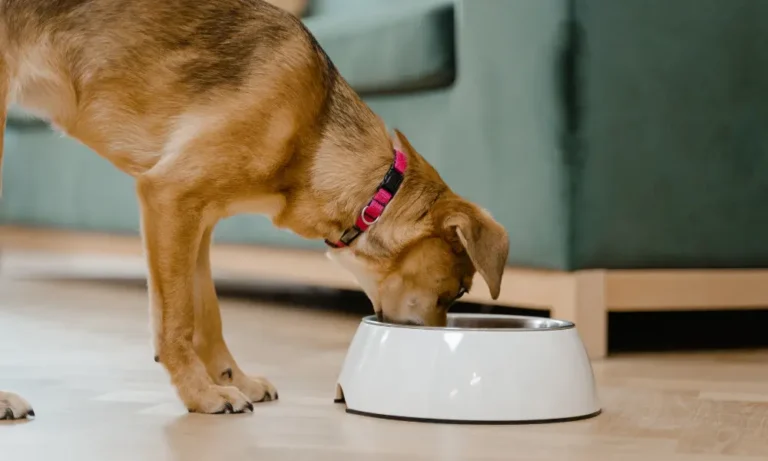Pears – those juicy, sweet orbs of deliciousness – have been a hit with us humans for ages. We gobble them up for their antioxidants and minerals. But wait, can dogs eat pears too? If that question has popped into your mind, keep reading. We’ll explore whether your four-legged buddy can partake in this healthy and tasty treat.
Another Interesting Read: Can Dogs Eat Pickles? What You Need To Know
Believe it or not, dogs can have pears. It’s not a forbidden fruit for them! As an occasional indulgence, your pup can munch on a slice of this green gem while you savor its succulence. However, it’s worth noting that not all dogs have a hankering for fruits, so don’t be puzzled if your furball isn’t intrigued. Just remember to cut the pear into tiny, bite-sized pieces and introduce a small nibble first to gauge their response.
Pears pack a punch of goodness for your pup. They’re loaded with calcium, potassium, magnesium, and vitamin A – all of which contribute to a well-balanced diet. Additionally, pears are a good source of dietary fiber, boasting around 5 grams per cup. Moderation is key when it comes to fiber intake. Begin by giving your dog a small portion of pear to ensure their tummy adjusts comfortably.
Pear’s Nutritional Benefits
Can dogs benefit from pears? Absolutely. For a healthy dog on a regular diet, pears can be an excellent addition. They’re a low-fat source of valuable micronutrients, contributing to your pet’s overall health:
- Vitamin C: Packing about 7.7 mg of vitamin C, pears possess anti-inflammatory properties and enhance immune function.
- Vitamin K: Vital for blood clotting, an average pear contains around 6.2 ug of vitamin K.
- Vitamin A: With approximately 45 IU of vitamin A, pears bolster the immune system, skin, and eye health.
- Potassium: Offering about 206 mg per pear, potassium aids heart, muscle, and nervous system functions.
- Dietary Fiber: Pears, boasting around six grams of fiber, support digestive health and regularity.
Pears are mostly water, constituting around 84% of their composition. Along with this hydration, they offer around 10 grams of carbs, 1 gram of plant protein, negligible fat, and about 2/3 grams of fiber. But that’s not all!
Pears are loaded with essential vitamins and minerals:
- Vitamin C
- Beta-carotene
- Niacin (Vitamin B3)
- Thiamin (Vitamin B1)
- Pyridoxine (Vitamin B6)
- Riboflavin (Vitamin B2)
- Folate (Vitamin B9)
Mineral-wise, pears deliver:
- Calcium
- Iron
- Potassium
- Iodine
- Magnesium
- Sodium
If your dog adores pears, they might fancy these dog-friendly fruits and vegetables as well:
- Cantaloupe: Another delicious melon brimming with micronutrients.
- Watermelon: A sweet and refreshing summer treat, loaded with antioxidants.
- Berries: Blueberries, blackberries, raspberries, and strawberries provide a vibrant burst of antioxidants.
- Pumpkin: Excellent for digestion and often recommended for upset stomachs.
- Apples: Similar in taste and texture to pears, they offer comparable micronutrients.
- Sweet Potato: High in fiber, this veggie promotes regularity and is pleasingly sweet.
- Kale: A nutrient-rich winter snack, if your dog enjoys the taste.
- Brussels Sprouts: A nutritious cruciferous green, great for adding variety.
Safely prepared pears can indeed make a delightful addition to your dog’s diet. Remember to slice them into manageable pieces, monitor quantities, and avoid seeds and cores. Always consult your vet if your dog has specific dietary requirements.
How Much Pear Can Your Dog Actually Have?
Veterinarians commonly suggest the 10% rule: treats, including fruits like pears, should constitute only 10% of your dog’s daily calorie intake.
Pears carry a decent sugar load, making them more calorie-dense than some veggies. Fresh pears contain about 10% sugar by weight, and a cup of chopped pears holds around 15 grams of sugar and 85 calories. This makes pears a periodic treat for dogs watching their calorie intake, but not suitable for dogs with diabetes. For a doggy-friendly veggie tray, blend pears with lower-calorie options like cucumbers and celery.
Beyond sharing the occasional pear slice, you can get creative with these pear-infused recipes for your four-legged companion:
- Chewy Dehydrated Pear Snacks: Try dehydrating pears for a satisfying chewy snack.
- Two-Ingredient Baby Food Dog Treats: Utilize pear baby food for these simple yet tasty treats.
These treats are perfect for beginners in the world of homemade dog goodies. Keep an eye out for baby food jars on sale for a variety of flavors to try. And guess what? You can make these treats gluten-free by using ground rolled oats as a wheat-free flour alternative.
- Prep Time: 10 minutes
- Cook Time: 24 minutes
- Total Time: 34 minutes
- Yield: Approximately 8 dozen small cookies
Ingredients:
- 1 4-ounce jar of baby food
- 1 cup flour
Instructions:
- Preheat the oven to 350°F (175°C).
- In a spacious bowl, combine one cup of flour with the baby food. Mix well.
- Gradually add more flour and knead the dough until it’s no longer sticky.
- Roll out the dough on a floured surface and cut out treat shapes. Place them on a baking sheet.
- Bake for 24 minutes or until the treats are cooked through, with the bottoms just starting to turn golden.
- For extra crispness, turn off the oven and leave the treats inside to cool and remove excess moisture.
What About Canned Pears?
When it comes to pears, fresh is better than canned. Fresh pears have less sugar than their canned counterparts, which are often soaked in sugary syrup. That syrup can lead to extra calories and more sugar intake, not great for your pup’s health.
Stay away from canned fruits for your dog. If your dog accidentally munches on a canned pear, it might lead to a minor upset stomach due to the sugar. However, consistent consumption of sugary foods could pave the way for more serious health issues like diabetes and obesity.
Before offering a pear to your pup, take a moment to prepare it properly. Remove the stem, leaves, core, and seeds, as these could pose choking hazards or blockages. Just like apple seeds, pear seeds, stem, and leaves contain traces of cyanide and should never be ingested. Remember, washing the pear skin thoroughly is fine for your dog. Slice the pear into bite-sized pieces to avoid any potential hazards.
- Pear Food Topper: Sprinkle some chopped or mashed pears on your dog’s regular food to add a burst of flavor.
- Pear Smoothie: Blend pear pieces with dog-safe fruits like bananas, blueberries, strawberries, apples, or peaches. It’s a delightful treat your dog will wag their tail for. Just remember, no more than 2 tablespoons of smoothie per 10 pounds of dog.
- Pear Yogurt Treat: Mash pear pieces into plain, sugar-free, and xylitol-free yogurt. Mix in other safe fruits too. Serve it cold as a refreshing snack or use it as a frozen treat by blending frozen fruit with yogurt.
- KONG Toy Stuffer: Fill your dog’s KONG toy with any of the pear mixtures. Freeze it for a cooling treat that keeps your pup occupied and entertained.
How Many Pears Can Your Dog Have?
Although pears are a delightful addition to your dog’s diet, remember that treats should only make up 10% of their overall intake. The rest should come from balanced dog food.
Here’s a guide based on your dog’s size:
- Extra-small dog (2-20 pounds) = 1-2 small pieces
- Small dog (21-30 pounds) = 2-3 pieces
- Medium dog (31-50 pounds) = 5-6 pieces
- Large dog (51-90 pounds) = a small handful
- Extra-large dog (91+ pounds) = a generous handful
While pears are a great choice, there’s a world of safe fruits your dog can munch on. Apples, bananas, blackberries, blueberries, cantaloupe, cranberries, honeydew, mango, oranges, peaches, pineapple, raspberries, strawberries, and watermelon are all dog-friendly fruits. If you ever have concerns about your dog’s diet or their specific health needs, don’t hesitate to consult your veterinarian. Happy snacking, furry pals!
Potential Risks and Caution
While pears are generally safe, it’s important to be aware of potential risks, especially if your dog consumes too much or ingests the seeds. Ingesting a significant amount of seeds could lead to cyanide poisoning, which may result in symptoms such as vomiting, diarrhea, lethargy, abdominal pain, shaking, and panting. If you suspect your dog has consumed pear seeds or exhibits any unusual symptoms, it’s wise to consult a veterinary professional.
Sugar and Dogs:
The pear, like other fruits, has its fair share of natural sugars. It’s worth noting that excessive sugar intake can lead to an upset stomach in dogs. Although the sugar content in pears isn’t excessively high, if your dog is grappling with diabetes, it’s prudent to consult your veterinarian before introducing any pear slices into their diet.
Sugar and Obesity:
Excessive sugar consumption also raises the specter of obesity. If your dog is grappling with obesity, it’s wise to offer them only tiny portions of pear and that too, infrequently.
Choking Hazard:
Dogs, regardless of their size, can encounter choking hazards or intestinal blockages if given whole pieces of food. To mitigate this risk, our steadfast recommendation is to cut any food, including pears, into bite-sized morsels. While smaller dogs are especially susceptible to choking on larger pieces, even larger dogs can fall victim to choking if they gulp down sizable chunks. It’s a universal truth that all dogs face the potential peril of blockages when confronted with excessively large food pieces.
Cyanide Concerns:
Steer clear of offering your furry friend pear seeds, leaves, and stems as they contain trace amounts of cyanide. The cyanide in the seeds is unleashed when they are either cracked open or crushed. Munching on the stem or leaves can also trigger the release of cyanide into your dog’s digestive system. However, even a small amount can prove perilous if your dog is sensitive to it.
Canned Pears Caution:
Canned pears may come with a considerable sugar content, and as a result, it’s best to steer clear of offering them to your dog. Given that excess sugar can pave the way for diabetes concerns or even contribute to obesity, it’s a prudent choice to avoid canned pears altogether.
Ripe vs. Unripe Pears:
When it comes to pears, the stage of ripeness matters. Ripe pears boast a soft, juicy flesh that’s safe for your furry companion to enjoy. However, green or unripe pears present a different story—they’re hard and quite the challenge to chew. To avert the possibility of a substantial tummy ache, it’s advisable to exclusively offer ripe pears to your dog. Moreover, unripe or green pears come with an additional peril: they can potentially become a choking hazard. And remember, before handing over a pear slice to your dog, it’s crucial to remove the core.
Conclusion | Can Dogs Eat Pears?
To ensure your dog’s well-being, keep a close eye on them after consuming pears. If you’re ever uncertain about the impact of pear consumption or notice any concerning symptoms, don’t hesitate to seek guidance from a veterinarian. Remember, your veterinarian understands your dog’s individual needs and can provide tailored advice based on their health and dietary requirements.
Pears can be a delightful and nutritious treat for your dog, but responsible feeding practices are crucial. By removing seeds, offering pears in moderation, and closely monitoring your dog’s well-being, you can enjoy sharing this tasty fruit with your furry companion.
FAQs:
You Might Also Like:




